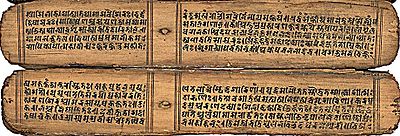History of Sanskrit
 12:08 AM
12:08 AM
 wahyu
wahyu
 Sanskrit is one of the Indo-European language of the oldest are still well known and include the longest history. Language that can match the 'age' of this language from the family of languages Indo-European Hittite language only. Sanskrit words, in Sanskrit means Saṃskṛtabhāsa is the perfect language. That is, the opposite of Prakrit, or vernacular.
Sanskrit is one of the Indo-European language of the oldest are still well known and include the longest history. Language that can match the 'age' of this language from the family of languages Indo-European Hittite language only. Sanskrit words, in Sanskrit means Saṃskṛtabhāsa is the perfect language. That is, the opposite of Prakrit, or vernacular. Sanskrit is a classical language of India, a liturgical language of Hinduism, Buddhism, and Jainism, and one of 23 official languages of India. This language also has the same status in Nepal.
Position in the culture of South Asia and Southeast Asia similar to the position of Latin and Greek in Europe. Sanskrit evolved into many modern languages in India anakbenua. This language appears in the pre-classical forms as the Vedic language. Contained in the book of the Rigveda is the oldest phase and most arkhais. This text comes from ditarikhkan approximately 1700 BC and Vedic Sanskrit are Indo-Aryan language of the oldest found, and one member of the family of Indo-European language of the oldest.
 Sanskrit literature which includes poetry has a rich tradition, drama and scientific texts, technical, philosophical, and religious. Currently Sanskrit is still widely used as a ceremonial language in Hindu rituals in the form of stotra and mantra. Languages spoken Sanskrit is still used in some traditional institutions in India and even some efforts to revive Sanskrit.
Sanskrit literature which includes poetry has a rich tradition, drama and scientific texts, technical, philosophical, and religious. Currently Sanskrit is still widely used as a ceremonial language in Hindu rituals in the form of stotra and mantra. Languages spoken Sanskrit is still used in some traditional institutions in India and even some efforts to revive Sanskrit. Which will be discussed in this article is the Classical Sanskrit as reviewed in the article Panini Sanskrit grammar, in about the year 500 BC.
Saṃskṛta-adjective meaning "civilized". The language referred to as saṃskṛtā profession "cultured language" by definition is always the language of "high", used for religious and scientific purposes and contrary to the language used by the commoners. The language is also called deva-bhāṣā which means "language of the Gods". Sanskrit Grammar oldest surviving compositions is Panini and berjudulkan Aṣṭādhyāyī ( "Eight-Chapter Grammar") which more or less ditarikh from the 5th century BC. This grammar is primarily a normative or prescriptive grammar is primarily regulate the use of a standard way rather than descriptive, although it also includes grammar sections mainly descriptive of Vedic forms that are no longer in use at the time of Panini.
Including Sanskrit Indo-Aryan branch of the family of Indo-European languages. Along with the Iranian language, Sanskrit language families including Indo-Iranian, and with this part of the group Satem languages Indo-European, which also includes Balto-Slavic branch.
When the term appeared in Sanskrit in India, this language is not viewed as a distinct language from other languages, but mainly as a form of subtle or cultured in the talk. Knowledge of Sanskrit was a marker of social class and language are taught mainly to members of higher castes, through careful analysis of such tatabahasawan Panini Sanskrit. As the language of Sanskrit scholars in India are in addition to the languages that are Prakreta vernacular and eventually evolved into the languages of modern Indo-Aryan (Hindi, Assamese language, Urdu, Bengali and so on). Most of the Dravidian languages of India, although part of different language families, they are heavily influenced Sanskrit, especially in the form of loan words. Kannada, Telugu and Malayalam has a number of words as the largest collection of Tamil language has the lowest. The influence of Sanskrit on languages is recognized by Tat same discourse ( "equal") and Tat bhava ( "root"). Meanwhile Sanskrit itself is also a language of Dravidian substratum influence from the very beginning.
(source)

 Posted in
Posted in

0 Response to "History of Sanskrit"
Post a Comment